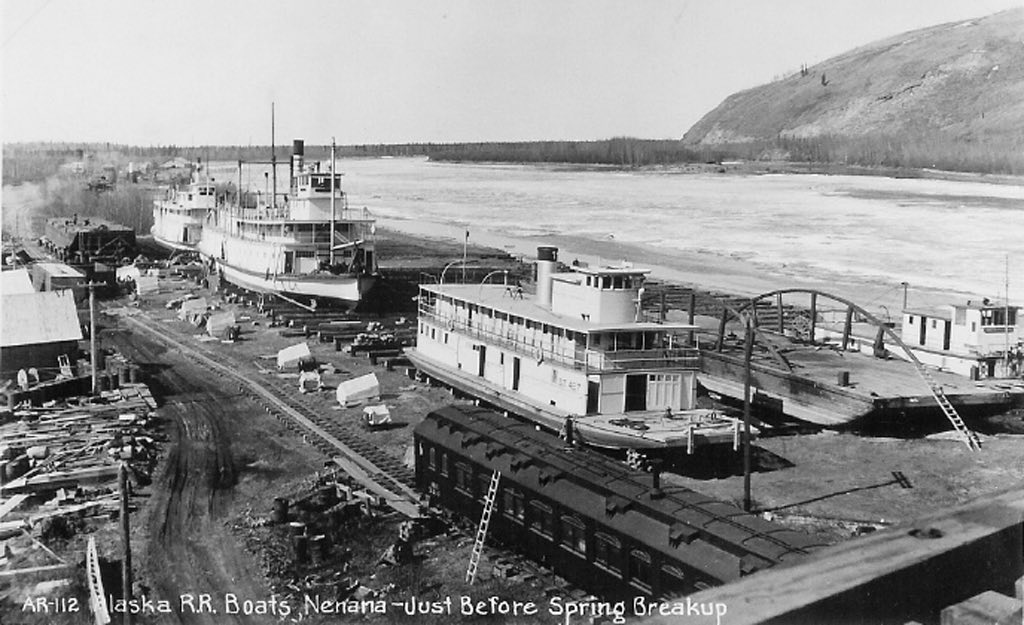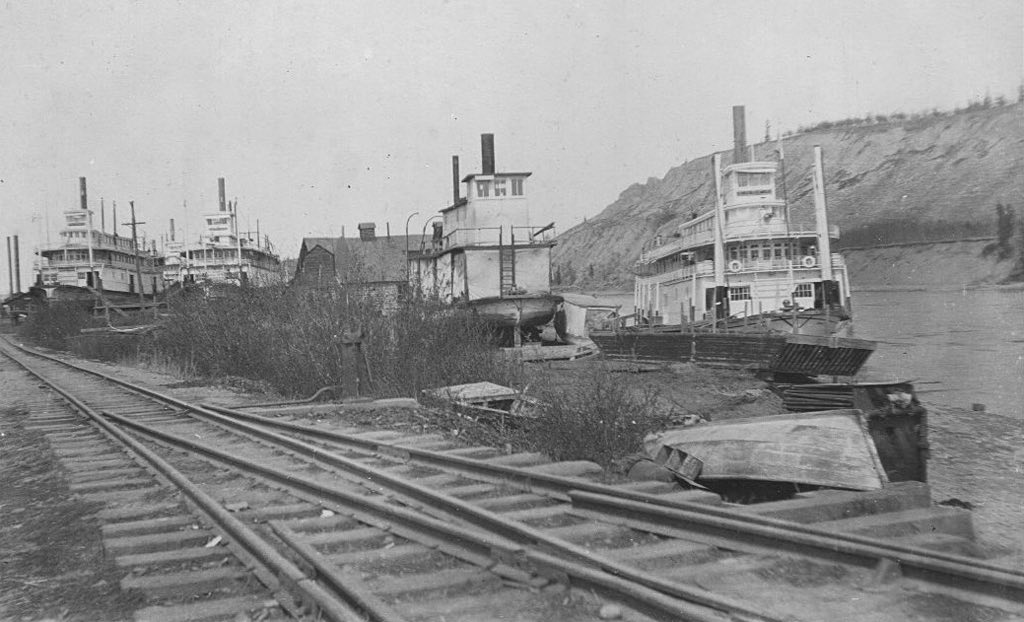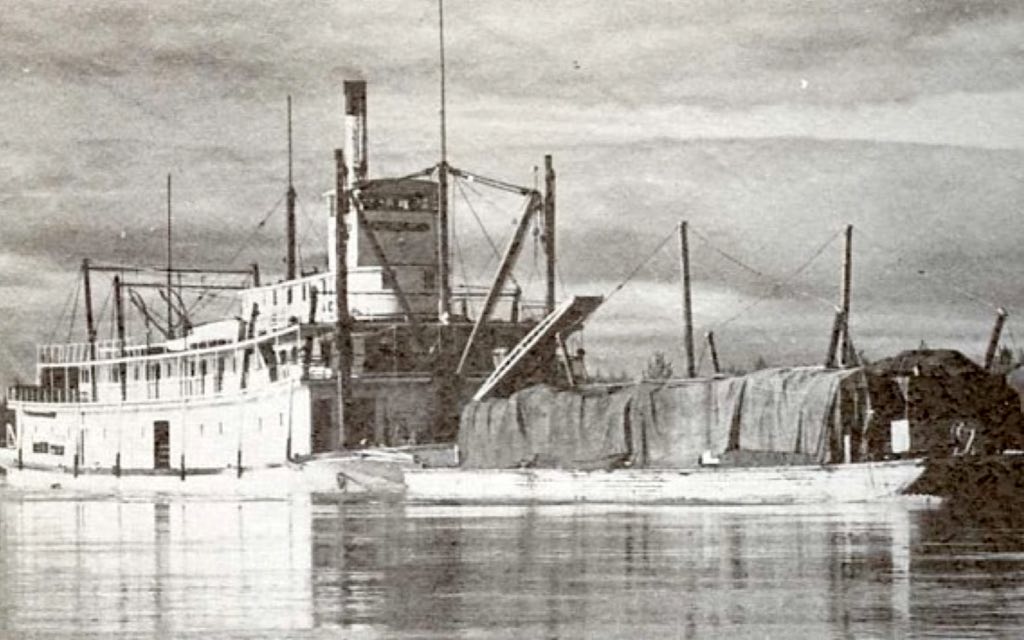
General Information Covering River Transportation System,
The Alaska Railroad
On March 1, 1955, consequent to call for bids, The Alaska Railroad awarded to B & R Tug and Barge Company, under terms of Contract No. 14-04-003-884, a transportation system, formerly operated by them on the Tanana and Yukon Rivers, together with all vessels and facilities, for a period of twenty years.
The Lessee, in turn, transferred interest to Yutana Barge Lines, Inc., who since that time have conducted operation as a private enterprise.
Historical background of The Alaska Railroad in river navigation began in 1916. The Alaska Engineering Commission, who were charged with construction of the Railroad by Congress, established docks and various terminal facilities 192 miles above the mouth of the Tanana River at a native village known as Tortella, and renamed the location Nenana. Materials were brought in through the Port of St. Michaels and Whitehorse, Yukon Territory, for construction of the Railroad from M.P. 348 (McKinley Park) to M.P. 470 (Fairbanks), until 1920. Vessels operated by the Northern Commercial Company and American Yukon Navigation Company handled this cargo. Statistics concerning the tonnage are unobtainable.
In May, 1923, the Interior Department, as authorized by Act of Congress, established a passenger, mail and freight service to be operated by The Alaska Railroad between Nenana and Holy Cross, a distance of 642 miles. Subsequently the route was extended to Marshall, 132 miles below Holy Cross, in 1925. A service was also established in 1946 to Circle; later, (1947), only operating to Fort Yukon.
Initiation of the service is attributed to arbitrary withdrawal of American Yukon Navigation Company from traffic below Fort Yukon in the fall of 1921, except an irregular service to Tanana, which later in 1942 was suspended to Circle. This company had, by purchase of Northern Commercial Company River Lines and various independents, become the sole operator of a navigation system available to the public. Every effort was made by the Interior Department to persuade the above company and various individuals to establish a stable service. By fall of 1922, conditions were so chaotic immediate action was essential unless the entire economy of river area would collapse.
Since 1900, the War Department, through the Army Transport Service, had supplied Forts Egbert, Hamlin and Gibbon as well as the Military Telegraph System along the Tanana and Yukon. Connections were made at Fort St. Michael with ocean carriers and at Whitehorse,Y.T. with rail lines of White Pass and Yukon Route.
Two small stern wheel steamers and two barges were maintained for the service.
In the fall of 1921, the War Department abandoned all installations in Alaska except Chilkoot Barracks at Haines, a small detachment at Anchorage and a few signal corps locations. Floating equipment thus inactivated was made available for The Alaska Railroad, without charge, in the fall of 1922 by Executive Order.
During the years following, this original equipment was replaced. A rehabilitated vessel (Steamer Alice) was put in operation in 1929, and retired in 1953. Steamer Nenana was acquired in 1933. Recently, the vessel was put up for bid. Other vessels used during the years were the “Yukon” and “Barry K” which was retired in 1946 and 1947 respectively. Various other barges were purchased and have since been retired. The Railroad constructed Barges 401, 201 and 301 in 1935, 1937 and 1943 respectively. In the years 1947 to 1951 various steel tank barges were built by the Railroad at Nenana. In 1953 motor vessels Tanana and Yukon and barges OB-2 and OB-3 were acquired. These hulls are the most modern of design for river service and have met the demands of a difficult service without failure. List of equipment available presently is listed and attached.
Cargo handled from 1923 to 1933 average around three thousand tons during the season of navigation of four and one-half months, which commences about May 15 and ends September 30. Due to low water, navigation on the average is almost impossible after that date. Tonnages 1933 to 1954 are attached.
Passenger traffic declined steadily from 1935 with advent of passenger aircraft. Mail service was completely taken over by aircraft in 1948. Passenger service, except to areas off route of aircraft, was suspended in 1949.
Distance within the area supplied by river vessels is container in the attached Distance Table 11-C, ICC No. 168, Additional distances are as follows:
| DISTANCES - YUKON RIVER ABOVE FORT YUKON | ||||||||||||||||||||||||||||||
|
||||||||||||||||||||||||||||||
| YUKON RIVER - BELOW MARSHALL | ||||||||||||||||||||||||||||||
|
||||||||||||||||||||||||||||||
| BEARING SEA VIA ST. MICHAELS CANAL | ||||||||||||||||||||||||||||||
|
| AVERAGE TOTAL ELAPSED TIME ROUND TRIP TO PRINCIPAL RVER POINTS | ||||||||||||||||||||
|
Above includes loading, unloading, navigational delay.
TONNAGE HANDLED BY YEARS
1933----1954
| Year | Tons |
| 1933 | 2482 |
| 1934 | 3376 |
| 1935 | 3166 |
| 1936 | 3925 |
| 1937 | 5215 |
| 1938 | 5635 |
| 1939 | 6007 |
| 1940 | 7419 |
| 1941 | 7900 |
| 1942 | 10203 |
| 1943 | 14039 |
| 1944 | 15693 |
| 1945 | 17365 |
| 1946 | 7662 |
| 1947 | 7234 |
| 1948 | 6649 |
| 1949 | 6575 |
| 1950 | 6155 |
| 1951 | 6576 |
| 1952 | 7488 |
| 1953 | 8047 |
| 1954 | 10655 |
| DESTINATION | TYPE & CONSTRUCTION | SERVICE | BURDEN TONS |
AT DRAFT |
LENGTH | BEAM | DATE ACQUIRED BY ARR |
| M. V. Tanana | Steel, 1200 H.P. Twin Screw Motor Vessel |
Towing | None | 3' 9" | 120' 4" | 35' | 1953 |
| M. V. Yukon | Steel, 1200 H.P. Twin Screw Motor Vessel |
Towing | None | 3' 9" | 120' 4" | 35' | 1953 |
| Str. Nenana | Wood, 1200 H.P. Stern Wheel Steamer |
Towing | 70 | 3' 9" | 238' | 42' | 1933 |
| Barge 201 | Wood, covered | Pkg. Frt. | 275 | 3' 8" | 130' | 34' | 1937 |
| Barge 301 | Wood, open | Pkg. Gen. | 340 | 3' 9" | 140' | 36' | 1943 |
| Barge 401 | Wood, covered | Pkg. Frt. | 400 | 3' 9" | 150' | 38' | 1935 |
| Barge OB. 1 | Steel, Bulk Oil | Bulk & Gen. | 210 | 3' 8" | 120' | 30' | 1947 |
| Barge OB. 2 | Steel, Bulk Oil | Bulk Gas & Gen. | 210 | 3' 8" | 120' | 30' | 1951 |
| Barge OB. 11 | Steel, Bulk Oil | Bulk Oil & Gen. | 180 | 3' 9" | 104' | 29' | 1947 |
| Barge OB. 12 | Steel, Bulk Oil | Bulk Oil & Gen. | 180 | 3' 9" | 104' | 29' | 1948 |
| Barge OB. 3 | Steel, Bulk Oil, JP-4, General | Bulk Oil & Gen. | 580 | 3' 9" | 175' | 44' | 1953 |
| Barge OB. 4 | Steel, Bulk Oil, JP-4, General | Bulk Oil & Gen. | 580 | 3' 9" | 175' | 44' | 1953 |
| Barge Stewart | Steel, Bulk Oil | Bulk Oil & Gen. | 385 | 3' 7" | 140' | 36' | 1951 |
RIVERBOATS
The riverboat NENANA was one of the modern sternwheelers in the River Boat Service run by the Alaska Railroad on the Yukon and Tanana Rivers. May 23, 1923 marked the inauguration of river transportation service by the Alaska Railroad on the Yukon and Tanana rivers. Floating equipment, sternwheelers DAVIS and JACOBS, was transferred to the railroad from the Transportation Corps of the US Army. In a gentleman's agreement to eliminate competition with the American Yukon Navigation Company, the Canadian company served the upper Yukon from Tanana to Dawson, and could steam up the Tanana to the railroad transfer point at Nenana. The ARR's River Boat Service delivered to down river to Tanana River and middle Yukon River points as far as Holy Cross (and later Marshall.) The Northern Commercial Company operated several small gas launches out of St. Michael and ran one boat per week upriver to meet the weekly steamer from Nenana. The system hauled tons of freight during World War II, but lost in excess of $150,000 in the post war years 1946, 1947, and 1948. After several acquisitions and trades, the Railroad decided to cease river trade. From the sale of river business, Yutana Barge Lines was born. When the NENANA went out of service it was moved to Fairbanks, Alaska, and is now available for viewing at Alaskaland.


Steamers and Sternwheeler c.1920's

Sternwheeler River Boat NENANA with military cargo going down the Tanana River. The fleet based in Nenana was Operated by The Alaska Railroad
See also:
Page created on 3/1/18 and last updated 4/24/19